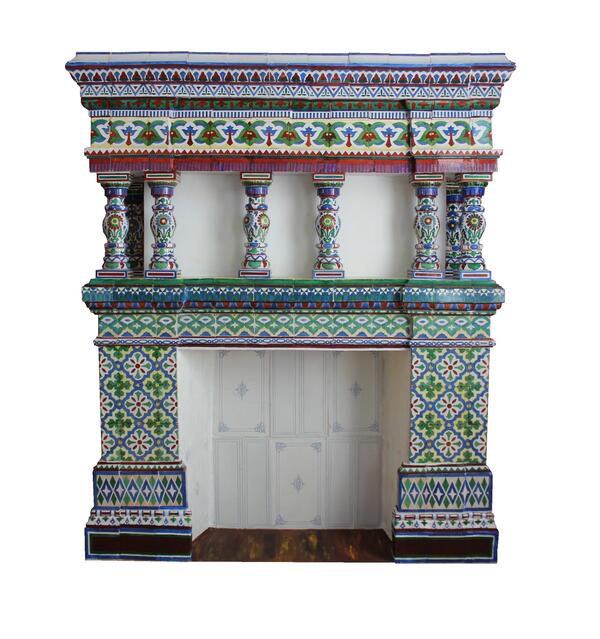In 2016, the 19th-century glazed tile fireplace was recreated for the exhibition ‘Usolye Collection of the Orlov-Davydovs’ of the Syzran Museum of Local History and Lore. The fireplace was originally mounted by owners of the estate and survived until 1974 while the building was owned by an agricultural college. The college moved to a new building leaving the estate ownerless and decaying. The fireplace was dismantled and handed to the museum. For a long time, it was kept in a storage room waiting for its new prime.
The fireplace was assembled by museum staff assisted by specialists from the Ural Regional Institute of Museum Projects. No design drawings survived, the works were carried out based on a single black and white photo from the 1970s. The fireplace was clad with vibrant glazed tiles in the Russian style with bright floral ornament. The tiles were used to improve the appearance and preserve heat.
Russian glazed tiles were traditionally decorated with ornaments of floral and plant elements, while oriental tiles had small patterns and images of animals and Dutch tiles depicted everyday scenes from the life of peasants in blue and azure colors on a white background. The tiles were of various shapes and sizes: flat, angled, or ornately shaped. They were not allowed to be parted. Only integral pieces could be used. First of all, they made a sketch and cast the pieces based upon it. Then, they assembled the framing by mounting the tiles on the hearth.
Glazed tiles are mainly distinguished from regular plates by the rump, a salient skirting on the back of a tile. Skirtings are intended to connect the tiles and preserve heat.
In earlier days, fireplaces were mounted in the homes of wealthy citizens, as well as royal palaces and even churches. Over years, human life became much easier: hearths were replaced with up-to-date, convenient, efficient, and small heating devices. Nowadays, nevertheless, we observe a rising tide of interest towards fireplaces as decorative elements.
The fireplace was assembled by museum staff assisted by specialists from the Ural Regional Institute of Museum Projects. No design drawings survived, the works were carried out based on a single black and white photo from the 1970s. The fireplace was clad with vibrant glazed tiles in the Russian style with bright floral ornament. The tiles were used to improve the appearance and preserve heat.
Russian glazed tiles were traditionally decorated with ornaments of floral and plant elements, while oriental tiles had small patterns and images of animals and Dutch tiles depicted everyday scenes from the life of peasants in blue and azure colors on a white background. The tiles were of various shapes and sizes: flat, angled, or ornately shaped. They were not allowed to be parted. Only integral pieces could be used. First of all, they made a sketch and cast the pieces based upon it. Then, they assembled the framing by mounting the tiles on the hearth.
Glazed tiles are mainly distinguished from regular plates by the rump, a salient skirting on the back of a tile. Skirtings are intended to connect the tiles and preserve heat.
In earlier days, fireplaces were mounted in the homes of wealthy citizens, as well as royal palaces and even churches. Over years, human life became much easier: hearths were replaced with up-to-date, convenient, efficient, and small heating devices. Nowadays, nevertheless, we observe a rising tide of interest towards fireplaces as decorative elements.



